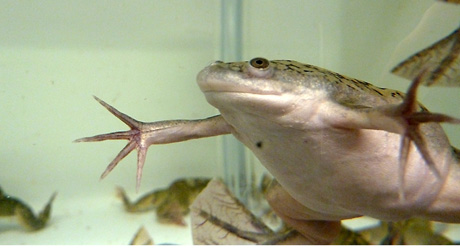National Xenopus Resource at MBL Innovates New Way to Study Proteins

FOR IMMEDIATE RELEASE Contact: Diana Kenney, Marine Biological Laboratory 508-289-7139; dkenney@mbl.edu
WOODS HOLE, Mass.— Proteomics, the study of large groups of proteins, can enhance our understanding of a wide range of organisms, with applications in medicine and developmental biology. Such analyses traditionally require a complete genome for the organism being studied in order to obtain a reference set of proteins. However, many organisms that hold potential for proteomic analysis do not yet have a completely sequenced and well-interpreted genome because the costs, in terms of both time and money, can be prohibitive. Xenopus laevis, the African clawed frog, is one such species.
A collaborative study between scientists at Harvard Medical School and the MBL’s National Xenopus Resource (NXR), published last week in Current Biology, has found a work-around. Instead of relying on DNA, researchers used mRNA sequences to more efficiently create a reference database that can be used for proteomic analysis of Xenopus.
“The mRNA is the product of a gene, so it’s simpler to sequence because the different [coding sequences] have already been spliced together,” said Marko Horb, the MBL scientist who contributed the mRNA sequences for the project. Horb is director of the NXR, a collaborative center that facilitates frog research through breeding programs and development of new experimental techniques. Harvard Medical School researchers Martin Wühr and Robert Freeman, Jr. (co-first authors on the paper), along with Leon Peshkin, have all taught at the NXR Bioinformatics Workshop at the MBL.
The researchers used their reference database to identify over 11,000 proteins from an unfertilized Xenopus egg and estimate the abundance of these proteins. The method outperformed comparison proteomic analyses based on a preliminary, unpublished Xenopus genome and other protein reference databases.
Their cost-effective solution opens the door for further proteomics experiments in frogs. “Xenopus is wonderful for proteomics, mostly because it’s easy to get a lot of proteins from highly interesting states,” said Wühr. Just one Xenopus egg—about a millimeter in diameter—provides about 30 micrograms of protein, which is sufficient for deep proteomic analysis.
The reference database that came out of this experiment is Xenopus-specific, but the same method could be applied to other species. To facilitate its use, the researchers provide a web-tool that will allow other scientists to convert mRNA data from other species into a protein reference database.
“For a lot of organisms, a high-quality sequenced genome won’t be available any time soon. The methods we developed are much easier to implement, and the results we obtained from our proteomic analysis are comparable to or better than those obtained with a genome close to being released,” said Wühr.
Citation:
Wühr M1, Freeman Jr. RM1, Presler M, Horb ME, Peshkin L, Gygi SP, Kirschner MW (2014) Deep Proteomics of the Xenopus laevis Egg using an mRNA-Derived Reference Database. Curr. Biol. 24: 1467–1475, DOI: 10.1016/j.cub.2014.05.04
1co-first authors
—###—
The Marine Biological Laboratory (MBL) is dedicated to scientific discovery and improving the human condition through research and education in biology, biomedicine, and environmental science. Founded in Woods Hole, Massachusetts, in 1888, the MBL is a private, nonprofit institution and an affiliate of the University of Chicago.
